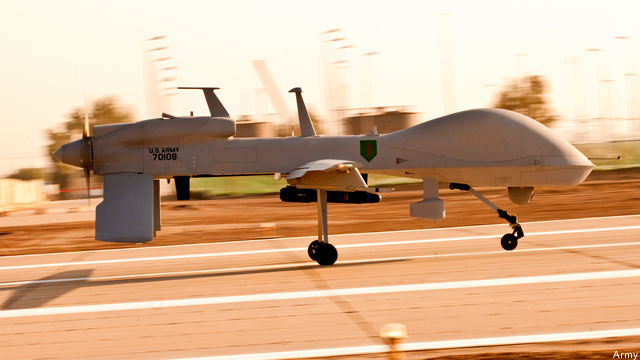The drone revolution, it appears, came along just in time for the Army. The service’s leaders have decided they can afford neither a new armed scout helicopter nor even the old ones they already own, but there’s always MUM-T — aka Manned Unmanned Teaming, in which manned aircraft work with unmanned aerial systems (UAS), aka drones. When Lt. Col. Pat Davis led an Army aviation battalion in Afghanistan last year, for example, his AH-64E Apache attack helicopter crews were helped by drones in some 60 percent of direct fire missions, Davis told Breaking Defense after a Boeing Company media breakfast Wednesday.
“It’s a phenomenal capability,” Davis said on the eve of an Association of the United States Army aviation conference. Davis was there to describe how pleased he and others in the Army are with the AH-64E, the latest version of the beefy, heavily armed attack helicopter known to some Taliban as “The Monster.”
Besides flying faster and farther than the AH-64D, the Echo model can “talk” to the Army’s MQ-1C Grey Eagle drone, a derivative of the Air Force MQ-1 Predator. That allowed Apache Echo crews in his unit to see full motion video of areas they were flying into or enemies they were being sent to attack well before they reached their destination.
“The ops tempo was very high,” Davis said, during the seven months his 1-229th Attack Reconnaissance Battalion spent in Afghanistan, which included the Echo model Apache’s first combat deployment. The unit’s 24 Apaches flew nearly 11,000 combat hours between March and November and maintained an impressive 87 percent Full Mission Capable rate, Davis boasted.
The battalion’s aircraft also included 15 OH-58D Kiowa Warrior scout helicopters — aircraft the Army has decided to retire under an Aviation Restructure Initiative (ARI) inspired by sequestration — and 10 UH-60M Black Hawk utility helicopters. Davis had no drones of his own to command, but he said his Apache crews made good use of the Echo model’s Tactical Common Data Link. The TCDL allows AH-64E crews to not only view a Grey Eagle’s video but also to control its sensors and even the drone and its two Hellfire missiles.
Coordinating by radio, the Apache crews also worked with other drones, Davis said, from small ScanEagles and RQ-7 Shadows to far larger Predators and MQ-9 Reapers, another Predator derivative far larger and more heavily armed than the Grey Eagle or MQ-1. The Reaper typically carries four Hellfires and two 500 pound bombs.
AH-64E crews can also take control of and aim a Grey Eagle’s sensors, a form of MUM-T known as LoI 3, for Level of Interoperability 3. Davis said his crews also did that, but less frequently. He added that, in training before they deployed but not in Afghanistan, his Apache Echo crews also practiced teaming with Grey Eagles at LoI 4, in which a manned aircraft crew controls the flight path of a drone and can launch its weapons.
The Army plans to give each of its divisions a company of Grey Eagles as part of its ARI, which in addition to retiring the venerable Kiowa Warrior – first flown in 1969 in its original version– includes a bitterly debated decision to take all Apaches away from Army National Guard units and give them to the active duty force. The Guard would get LUH-72 Lakota and Black Hawk utility helicopters instead.
Col. Jeff White, who oversees reconnaissance and attack helicopter requirements for Army Training and Doctrine Command (TRADOC), told the Boeing breakfast that “Manned Unmanned Teaming (is) an important part of our bridging strategy as we lose the Kiowa Warriors.” But White said the Army was just “scratching the surface” in its use of MUM-T.
Indeed, Davis said the in-flight use of drones by 1-229th Apache Echo crews wasn’t part of a plan but an ad hoc use of available resources. “It all depended on who showed up,” he said. “Sometimes the linkup (between Apaches and drones) would be done on station while they were at the mission location” and “sometimes it was by chance that they (drones) happened to be in the same area we were operating in, or they got called into an operating area.”
So as a commander, having used both OH-58Ds and drones to perform reconnaissance, which does Davis prefer? “A lot depends on what your mission set is,” he said. A helicopter with a human being inside can provide better situational awareness by “actually being on the mission and seeing it, smelling it, hearing it,” Davis offered. “But having the capability of an unmanned system that could get up a lot higher (10,000 to 15,000 feet) and still have those capabilities that it brings to the fight – having it available and allowing us to stand off where we’re not seen, not heard – there’s a lot to be said for that.”
In a ‘world first,’ DARPA project demonstrates AI dogfighting in real jet
“The potential for machine learning in aviation, whether military or civil, is enormous,” said Air Force Col. James Valpiani. “And these fundamental questions of how do we do it, how do we do it safely, how do we train them, are the questions that we are trying to get after.”




























